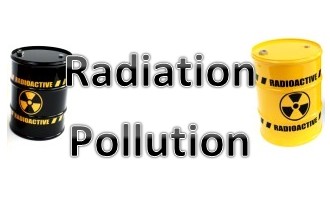Radiation Pollution
Radiation is one of the chief forms of energy consisting of high energy particles. Radiation could be natural (Solar & Cosmic) or man-made (Nuclear). Radiation has also become a major factor causing environmental pollution.

Radiation may have both short term and long term effects. They can further be divided functionally into:
a. Ionizing and
b. Non Ionizing
Nuclear Radiation and its Harmful Effects
Radiations emitted by nuclear substances or wastes (fallout) or from atomic power plant or an atomic explosion cause nuclear radiation. Nuclear wastes continue to emit radiation for a very long period.
Radioactive iodine (131I) and Strontium (90Sr) are two nuclear wastes from an atomic explosion and may cause cancer of thyroid and cancer of bone marrow respectively. By entering food chain they also get accumulated in high concentration in the body of the too consumer causing harmful effect on the health of both man and animal.
Nuclear Waste
As in many other industrial processes, in the nuclear industry also, one gets unusable and unwanted waste products; the residues turn out to be hazardous.
Nuclear waste can be generally classified as either 'low level' radioactive waste or 'high level' radioactive waste.
Low-Level Radioactive Waste
The radioactivity contained in the low-level radioactive waste is significantly less and made up of isotopes having much shorter half-lives than most of the isotopes in high-level radioactive waste.
Large amounts of waste contaminated with small amounts of radio-nuclides, such as contaminated equipment (glove boxes, air filters, shielding materials and laboratory equipment) productive clothing, cleaning rag, etc. constitute low level radioactive waste. The level of radioactivity and half-lives of radioactive isotopes in low level waste are relatively small.
Storing the waste for a period of 10 to 50 years will allow most of the radioactive isotopes in low level waste to decay, at which point the waste can be disposed of as normal refuse.
High Level Radioactive Waste
High level radioactive waste is the spent fuel, the liquid effluent arising from the reprocessing of spent fuel and the solids into which the liquid waste is converted. It consists, generally material from the core of a nuclear reactor or a nuclear weapon. This waste includes uranium, plutonium and other highly radioactive elements created during fission, made up of fission fragments and transhumances. These two components have different times to decay. The radioactive fission fragments decay to different stable elements via. Different nuclear reaction chains involving a, β and ¥ emissions, and this would take about 1000 years. Heat output lasts over 200 years. Most of the radioactive isotopes in high level waste emit large amount of radiation and have extremely long half-lives (some longer than 100,000 years), creating long time-periods before the waste will settle to safe levels of radioactivity.
Waste management means the entire sequence of operations starting with generation of waste and ending with disposal.
Radioactive waste management involves minimizing radioactive residues, handling waste packing safely, storage and safe disposal in addition to keeping sites of origin of radioactivity clean. Poor practices lead to future problems. Hence choice of sites where radioactivity is to be managed safely is equally important in addition to technical expertise and finance, to result in safe and environmentally sound solutions.
The International Atomic Energy Agency (IAEA) is promoting acceptance of some basic tenets by all countries for radioactive waste management. These include:
(i) Securing acceptable level of protection of human health.
(ii) Provision of an acceptable level of protection of environment.
(iii) Acceptable impact on future generations and
(iv) No undue burden on future generations. There are other legal, control, generation, safety and management aspects also.
Average Acceleration Calculator
Average acceleration is the object's change in speed for a specific given time period. ...
When an object falls into the ground due to planet's own gravitational force is known a...
In Mathematics, the permutation can be explained as the arrangement of objects in a particular order. It is an ordered...
A rectangle can be explained as a 4-sided quadrilateral which contains equal opposite sides. In a rectangle
A three sided polygon which has three vertices and three angles is called a triangle. Equilateral triangle...







